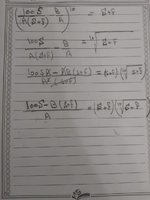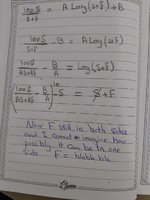Hi
I am working in the software industry, and I am trying to reach a formula in order to use it in a piece of software. In the field of business solutions we do not usually face such an equation, and it is relatively difficult to me.
I have an excel sheet which led me to a deduce an equation: Current Percentage (CP) = Target Percentage (TP). At this point, the number of foreigners (F) will be maximum. I need to get F Given that
CP = 100 S / (S+F)
TP = A Log (S+F) + B
Thus: 100 S / (S+F) = A Log (S+F) + B
All my attempts failed because I always reach a point in which F is in both sides of the equation, and I need to get F = bla bla bla. Please check the below images.
Attempt

Attempt (closer I think but still stuck)

I am working in the software industry, and I am trying to reach a formula in order to use it in a piece of software. In the field of business solutions we do not usually face such an equation, and it is relatively difficult to me.
I have an excel sheet which led me to a deduce an equation: Current Percentage (CP) = Target Percentage (TP). At this point, the number of foreigners (F) will be maximum. I need to get F Given that
CP = 100 S / (S+F)
TP = A Log (S+F) + B
Thus: 100 S / (S+F) = A Log (S+F) + B
All my attempts failed because I always reach a point in which F is in both sides of the equation, and I need to get F = bla bla bla. Please check the below images.
Attempt

Attempt (closer I think but still stuck)

Last edited:
